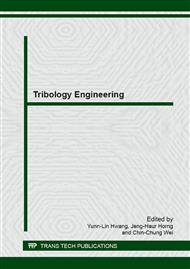[1]
Hertz, H. , Uber die berührung fester elastischer körper , J. Reine and Angewandte Mathematik , 92(1882), pp.156-171.
DOI: 10.1515/9783112342404-004
Google Scholar
[2]
Kikuchi, N. And Oden, J. T. , Contact problems in elasticity: a study of variational inequalities and finite element methods, SIAM Studies in Applied Mathematics, Philadelphia (1988).
DOI: 10.1137/1.9781611970845
Google Scholar
[3]
N. Ye, K. Komvopoulos, Three-Dimensional Finite Element Analysis of Elastic-Plastic Layered Media Under Thermo-mechanical Surface Loading, Journal of ASME J. Tribology, Vol. 125 (2003), pp.52-59.
DOI: 10.1115/1.1497360
Google Scholar
[4]
Z. Q. Gong, K. Komvopoulos, Mechanical and Thermomechanical Elastic-Plastic Contact Analysis of Layered Media With Patterned Surfaces, ASME J. Tribology, Vol. 126 (2004), pp.9-17.
DOI: 10.1115/1.1609487
Google Scholar
[5]
S. Hasan, O. Alaettin, Thermomechanical analysis of elastoplastic medium in sliding contact with fractal surface, Tribology International, Vol. 41 (2008), pp.783-796.
DOI: 10.1016/j.triboint.2008.01.010
Google Scholar
[6]
R. R. Katta, E. E. Nunez, A. A. Polycarpou, S. C. Lee, Plane strain sliding contact of multilayer magnetic storage thin-films using the finite element method, , Microsyst Technol, Vol. 15, pp.1097-1110, (2009).
DOI: 10.1007/s00542-009-0859-5
Google Scholar
[7]
H. Pelletier, C. Gauthier, R. Schirrer, Relationship between contact geometry and average plastic strain during scratch tests on amorphous polymers, , Tribology International, Vol. 43 (2010), p.796–809.
DOI: 10.1016/j.triboint.2009.11.006
Google Scholar
[8]
P. Sahoo, B. Chatterjee, D. Adhikary, Finite Element based Elastic-Plastic Contact Behaviour of a Sphere against a Rigid Flat-Effect of Strain Hardening, , International Journal of Engineering and Technology Vol. 2 (2010), pp.1-6.
DOI: 10.4236/eng.2010.24030
Google Scholar
[9]
B. Chatterjee, P. Sahoo, Elastic-plastic Contact of a Deformable Sphere Against a Rigid Flat for Varying Material Properties Under Full Stick Contact Condition, , Tribology in industry, Vol. 33 (2011), pp.164-172.
DOI: 10.1155/2012/472794
Google Scholar
[10]
H. Pelletier, J. Krierb, C. Gauthier, Influence of local friction coefficient and strain hardening on the scratch resistance of polymeric surfaces investigated by finite element modeling, Procedia Engineering, Vol. 10 (2011), pp.1772-1778.
DOI: 10.1016/j.proeng.2011.04.295
Google Scholar
[11]
A. Gasmi, P. F. Joseph, Contact solutions for a circular orthotropic beam accounting for transverse normal strain, , International Journal of Engineering Science, Vol. 55 (2012), pp.1-17.
DOI: 10.1016/j.ijengsci.2012.01.011
Google Scholar


